#nemopilema nomurai
Text
Daily Jellyfish #3 - Nemopilema nomurai
Nemopilema nomurai (Animalia; Cnidaria; Scyphozoa; Rhizostomeae; Rhizostomatidae) AKA 'Nomura's Jellyfish'.

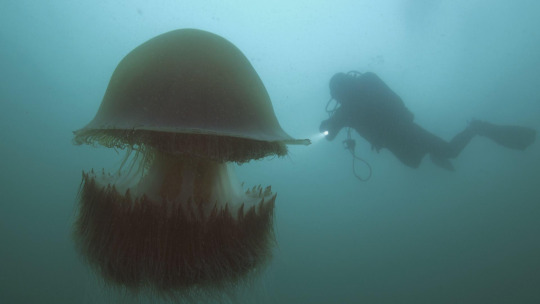
© PBS LearningMedia
N. nomurai are known to grow up to 2m in diameter, and weigh up to 200kg. They are the second largest known jellyfish in the world, just trailing behind Cyanea capillata (Lions Mane Jellyfish), and can grow from the size of a grain of rice to their full size within six months.
Supposedly, they live in a depth range of about ~0-176m in the Epipelagic (Sunlight) Zone. Primarily, they are found in the waters between China and Japan - most notably the Yellow and East China seas.

© Y. Taniguchi
For the last ~20 years, population blooms in N. nomurai have been increasing greatly - causing great economic damage to Japanese fisheries. To combat these overpopulation blooms, recent research has sought to find ways to convert into resources (i.e. food, medicine, and agricultural tools).
When under attack or threat, N. nomurai will release billions of sperm or eggs which then attach to rocks and corals. These then grow into even more jellyfish (sometimes millions) at later times, making removal of these jellyfish very difficult.
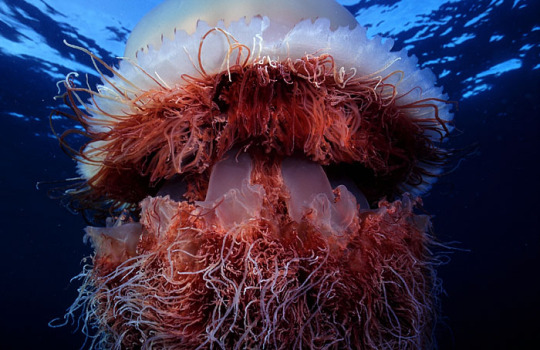
© Hushigi
Feeds mostly off of zooplankton and larger fish, to which they poison for easier consumption, and devour them with their hundreds of microscopic mouths.

Masterlist! // Honestly such a haunting jellyfish, the sheer size of them is absolutely terrifying. I love their stinging tentacles! The way they billow out is beautiful <3

#informative#info dump#marine science#marine biology#marine life#nemopilema nomurai#n. nomurai#nomura's jellyfish#jellyfish#jellies#daily jellyfish#personal project
8 notes
·
View notes
Photo

The Nomuras Jellyfish (Nemopilema nomurai) is a large rhizostome jellyfish (same size class as the Lions Mane Jellyfish) it is 2 yards across and 450 pounds at full maturity. Their habitat is mostly Japanese waters and the waters between China and Japan. The cool thing about it is that its starts off as smaller than a grain of rice or a dime, barely weighing a thing and in under a year it becomes fully mature!! They’re becoming a huge problem due to climate change with jellyfish blooms (Or booms in population) are happening every single year instead of every 40 years as to be. This is a problem because fish stung by jellyfish are contaminated with venom and cannot be sold or eaten, because of their large size when they’re caught in nets they damage and break them, and they’re hella good at reproducing like at a minimum there is serval billion in the Japanese waters at a time during certain seasons. They can also be eaten although they are not considered high quality jellyfish, a company called Tango Jersey Dairy uses Nomuras Jellyfish in their vanilla jellyfish ice cream, also students in Japan have created caramel using Nomuras jellyfish, and another Japanese businessman has developed many products ranging from cocktails to makeup using jellyfish (sometimes Nomuras Jellies).
https://thescyphozoan.ucmerced.edu/Org/JotQ/JotQ_07Aug.html
https://florida.pbslearningmedia.org/resource/nomuras-jellyfish/nomuras-jellyfish/
#nomuras#nomuras jellyfish#jellyfish#nomurasjellyfish#japan#japanesejellyfish#japanese jellyfish#ceruleanmoonjellies#jelly#nemopilema#nemopilema nomurai#nemopilemanomurai#lions mane jellyfish#can you tell im hyperfixating#jellies
3 notes
·
View notes
Text
Jelly n.31 - 🌪️ CAHUNCA 🌪️


● Its tentacles are very spongy but better not to touch them, they cause hives.
● When many Cahunca gather on a beach it is a sign of bad luck. Probably a storm is coming.

#tornado#house#casa#medusa#jellyfishers#jellyfish#video games#indiedev#indiegamedev#gaming#gamedev#art#indie games#nemopilema#nomurai
1 note
·
View note
Text
Walking on Glass
And I do solemnly swear that this is the last set of new trolls I make for a long while.
So what’s the Colmea guy’s deal, anyway?
[doc]
--
“Now you’ve really done it.” The child, and she can’t be more than five sweeps old, smiles around a juicebox from her perch. “He’s not going to be happy about this one little bit.” Her warning fills you with just enough dread that it roots you in place.
The he in question is, for the short time that you’ve known each other, very particular of the fungal colonies that throng throughout the lab like a great big web. Some of them in larger terrariums cobbled together and the others in their much smaller quarantines. He was more protective of these small quarantined batches than he was of anything else, even the aquarium that sits nearly ceiling to floor and across the back wall of the lab, housing a handful of species of jellyfish, with the largest, and need for such ample volume, being his overgrown lusus. Nemopilema nomurai, he once whispered into your ear when he caught you staring at her.
She is quite the daunting thing, with what must be a ten or fifteen-foot diameter and countless feet of long sprawling tentacles, tendrils, and tangles of some sort of marine fungus weaving around and within them. He never offered a scientific name or approximate for it, and to be fair, you never asked.
Conversations with the man always centered around his research, his precious colonies, that you’d been helping him with. The science he always mumbled, mostly to himself, was difficult to parse on a good day, on a bad day he stopped pretending to try altogether.
Your role, as far as he was concerned, as far as you understood, was only a very small part.
A collective consciousness. The only colony that survived the interaction with your mutation to the point that you started to become one. Once again, the science of it all was lost on you, something about parasitic symbiosis or some other, but the piece of it he’d gotten into you somehow took root and you’d found yourself actually talking to it.
Making decisions with it.
It was only natural you’d want to get a closer and better look at it, right?
“It was a mistake.” Is all you can manage, staring at the ground that almost glitters with the way the ambient lights of the tanks shine off of the glass of one of the smaller, now shattered, terrariums that litters the floor. Many of the stray shards lance through the colony in places that look fatal even to the untrained eye.
“It was a mistake.” She mimics, not quite getting the cadence right, but the road work is there, so there’s maybe a future in ventriloquism for the kid. “I think he’s gonna feed you to Big Mama.” She indicates the tank with the massive jellyfish in it, punctuating the thought with the insufferable sound a straw makes when it reaches the end of a drink.
Colmea couldn’t be that unreasonable, could he?
As if summoned, and you don’t think she sent for him, the door opens as soon as the fear creeps up on you.
There is a severe way that the doctor has about carrying himself, a stern expression attached to whatever it is he lets his gaze fall on. Right now that is solidly on you. The gravity of the situation and the weight of the girl’s words leave you incapable of removing yourself from the scene of the crime, after all. You’d only reached a harmless hand in to touch it, how could you predict this outcome?
“It was a mistake.” You whisper desperately as he fully enters the room, the picture of serenity, taking in the scene before him. He does not regard you or what you’ve had to say for yourself.
Even if the colony was not sliced through as it was, the abrupt displacement from its aquatic habitat would have done enough on its own to paint a grim scene, splattered across the floor like an abstract painting. He surveys the damage quietly, a ponderous god, visage poisoned by the blue and pink glow of the lights within neighboring tanks. Now his gaze flits about from shard of glass to shard of glass, as though looking for answers in the mosaic they make up on the floor.
Everything in the lab has become remarkably still, even the girl in the corner has ceased vacuuming the bottom of the juice box in favor of savoring the silence that smothers the room, deafening even over the bubbling of the surrounding tanks.
Colmea does not rush in, ready to collapse to the floor and mourn the loss of his experiment, instead he is carried further into the room by slow and deliberate steps, each one a soft tap against linoleum that crushes the glass beneath it. The answers to questions that he does not bother voicing slotting into his mind as he advances, and if those answers change any part of his expression, which you suspect it doesn’t, it goes unnoticed when his contemplative steps take him into the shadow of his colossal lusus.
Far too long passes before he is standing directly in front of you. Very briefly, a crack in his veneer provides a view into the ever-feared high blood rage bubbling beneath the surface.
“Myriad,” he addresses the girl, still up on her perch by the edge of the jellyfish enclosure. “The colony?”
Myriad makes a face like she is seriously concentrating, an expression you’ve come to understand means she is reaching into her mind to find her natural connection to the fungal colonies that surround her. Not as a member of the collective, but as an eavesdropper. Her game goes on for too long and it is clear that she is only playing up the dramatics, reveling in your dread, when the pensive god clears his throat.
“Dead as a doornail!” She reports, cheery as she was when she delivered her taunts moments before his arrival. It should hurt, but you already knew. You felt it, a part of you, die the second the tank hit the floor. “No survivors, wiped out!”
The ghost of something horrific crosses behind his eyes.
He nods.
His demeanor does not betray him and there is no warning when he strikes, just the stinging feeling left behind by a backhand that causes you to lose your balance. With a hideous crunch, your knees fall into the ruin below, the salty remnants from the enclosure mingles with the fresh wounds and sends a significant shock through your system. So significant in fact, that you make neither a move nor a sound.
Colmea shakes his hand loose, the anger that boils just beneath but never quite breaking the surface places a dangerous dose of malice behind his eyes.
“Myriad, find me a broom.” He commands, and as soon as it leaves his mouth, her feet hit the ground right behind you with a crunch that makes you wince. A stifled giggle followed by her plodding along tells you it was an intentional assault on her part.
His hand is wrapped up in your hair before the door closes behind her and he lifts you up to meet his eye line, all the while winding more and more of it up until he finds scalp, as though he is handling something that weighs about the same as a stuffed animal.
There is no growling, no deep orange eyes signaling danger, just a furrowed brow and a deep sigh. “I had such high hopes for you.”
“I,” you start to plead your case, tears welling at the corners of your eyes at the realization that your mutation did not make you special enough, but he does not give you the opportunity to continue. Instead, your face is acquainted with the glass of the aquarium with such force that it rattles the base of the enclosure and causes some of the smaller species of jellies inside to send off bright sparks of light, in hopes of startling whatever predator they assume has invaded.
All they really succeed in is disorienting you all the more, your face making contact a second and third time before stars start to decorate your vision and the edges begin to blur. Something cracks, and it is not the glass.
Still, the angered god does not growl or snarl. Nor does his reflection, warped by a myriad of things between the forming concussion and the glass of the aquarium, broadcast anything beyond his mild indifference.
Your face hits the glass a few more times before the girl returns from her quest and he finally relents, dropping you to the floor with a sigh. In the same moment, the stars in your vision become angry black splotches, eagerly rushing out to meet those blurred edges.
43 notes
·
View notes
Note
How about "medusa" for itayoshi? X3 (medusa is one of the forms of the jellyfish life cycle 😉)
Oh gosh, digging through my brain so hard for this-- I was watching the show when season 1 aired, and my sister and I both got so bamboozled by how it went down--I MEAN!! The ending credits?!?!? They were basically boyfriends??--so for my own sanity I will imagine that I could only ever write happy AUs for them. SO.
medusa | T | Itadori Yuuji/Yoshino Junpei | 2k+
One-shot, AU, Meet Cute
Summary: There are many perks to being a marine biologist.
One such perk, Junpei finds, is when the diver who's accompanying you and capturing specimens for analysis on your newest expedition, a) enjoys the same obscure cinema as you do, and b) is a really good swimmer...
which comes in handy when Junpei (who is a terrible swimmer) leans a bit too far out of the boat to try and get a good glimpse of this absolutely amazing specimen of a fully adult Nemopilema nomurai. (At least his diver agrees, "That jellyfish was HUGE, wow.")
-
Thank you for playing! Send me a made-up fic title
13 notes
·
View notes
Text
Animal Crossing Fish - Explained #144
Brought to you by a marine biologist with a native animal gone wild...
CLICK HERE FOR THE AC FISH EXPLAINED MASTERPOST!
Okay, so, I know my intro doesn’t make sense right now, and that’s fine; I’m here to explain. Ecology is the study of ecosystems - how organisms and inorganic resources interact in all their beautiful, complex ways. Think food webs as the most well-known example in this field of study. You’ll find that everything is in a quasi-perfect balance (as it should be), and when you tweak one of the gears in this machine, you’ll find the machine starts to act funny. For instance, if you remove apex predators, their prey will experience a rise in their population, which could severely hurt the population of their prey, and so on. This is called a trophic cascade. This can also happen if you add non-native species (invasive species) into a system they don’t belong. Sometimes, a native species can start wreaking havoc in this way, and one of the best examples of this is today’s floaty friend, the Nomura’s Jelly, which was available this summer in Pocket Camp:

Native to the East China Sea, the Yellow Sea, and Sea of Japan, Nomura’s Jelly (Nemopilema nomurai) has always been a common sight in these areas. They’re actually quite astounding to see, as they are one of the largest jelly species, with a bell diameter of 6+ feet (2m)! They are just one of many species within the Class Scyphozoa, the true jellies. Within that Class, Nomura’s Jelly is within the Order Rhizostomae, an order of jellies in which do not have any tentacles extending from the edge of the bell, and have feeling arms instead underneath. This makes it very different than the Moon Jelly we covered a while ago, but nevertheless, it’s a drifter that eats anything unlucky enough to succumb to its venom.

It’s so big, some of the things that succumb to its venom are humans, though those humans don’t get eaten by it. Yeah, don’t fuck around with this thing.
Nomura’s Jelly populations have been blooming out of control recently in their native range. Called “the jellyfish joyride”, Nomura’s isn’t the only jelly on it. In recent decades, jellies of all kinds have been steadily replacing fish in the world’s oceans. A lack of predators (they didn’t have many to begin with, but humans just so happen to find their predators delicious (tuna and swordfish), or are making it really hard for them to survive (sea turtles)), warming seas, and injections of nutrients (such as lawn and farm fertilizer washing into the sea) so their plankton food thrives, have become the trifecta of the jellyfish joyride. Humans are acutely aware we’ve fucked this up, so we’re trying to find ways to mitigate it.

https://weeklyworldnews.com/headlines/13233/nomuras-jellyfish/
Attempting to eradicate the Nomura’s Jelly, or any Jelly, for that matter, is easier said than done. Although fishing for them and using them as a food source and medicines, it’s too little too late. Ya see, once jellyfish are on that joyride, it’s really hard to remove them from their new throne as dominant species. This is because they actively eat small fish, especially fish larvae, including the larvae that would have grown up to be the jelly’s predators. It’s a terrible feedback loop. What needs to be done is to prevent the joyride to begin with, but, ya know, we’re a reactive society that still doesn’t understand that maybe being proactive about shit might just save us a ton of money and hassle. *Heh*, just one of the many drawbacks to being a marine biologist is watching this shit happen and no body wants to listen to you STILL.
And there you have it! Frustrating af, no?
#jellyfish#nomuras jellyfish#jelly#marine biology#animal crossing#animal crossing pocket camp#science in video games#animal crossing fish explained
5 notes
·
View notes
Text
Που οφείλεται η επιδρομή από τις τσούχτρες;
Που οφείλεται η επιδρομή από τις τσούχτρες;
Που οφείλεται η επιδρομή από τις τσο��χτρες; Νέα μελέτη υποστηρίζει ότι ο μεδουσο-Αρμαγεδώνας οφείλεται στην ανθρώπινη δραστηριότητα… (more…)
View On WordPress
#cotylorhiza turberculata#Environment Research Letters#Nemopilema nomurai#New Scientist#pelagia nuctiluca#ανθρώπινη δραστηριότητα#αποφυγή τσιμπημάτων#διατροφική αλυσίδα των θαλάσσιων ειδών#ειδήσεις Ελλάδα#ειδήσεις Κρήτη#επιδρομή από τσούχτρες στις ελληνικές θάλασσες#θαλάσσια ρύπανση#μέδουσα «Κοτυλόριζα»#μέδουσα «Πελάγια»#μέδουσες#μέδουσες-τέρατα#μεδουσο-Αρμαγεδώνας#μέτρα προστασίας από τσούχτρες#μέτρα προφύλαξης από μέδουσες#μέτρα προφύλαξης από τις μέδουσες#μέτρα προφύλαξης από τις τσούχτρες#μέτρα προφύλαξης από τσούχτρες#μέτρα προφύλαξης για λουόμενους#μέτρα προφύλαξης στις διακοπές#περιοδικό περιβαλλοντικών ερευνών "Environment Research Letters"#συμβουλές#συμβουλές για προστασία από τσούχτρες#τσίμπημα τσούχτρας#τσούχτρες
0 notes
Photo
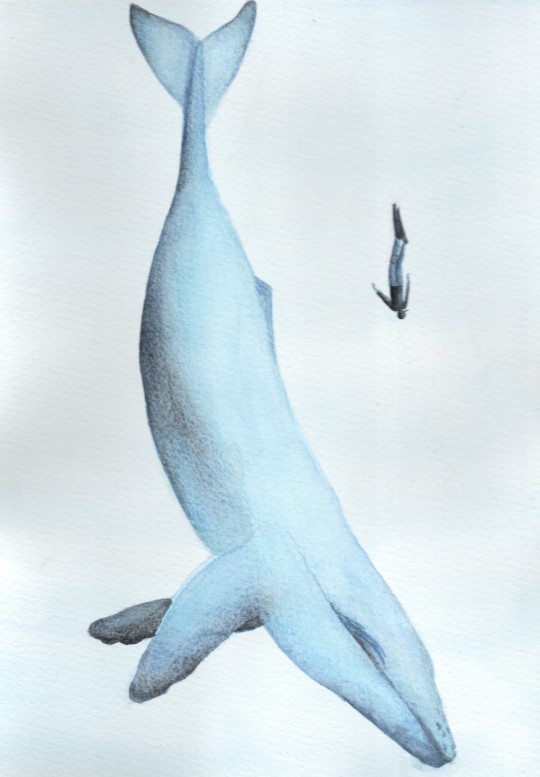
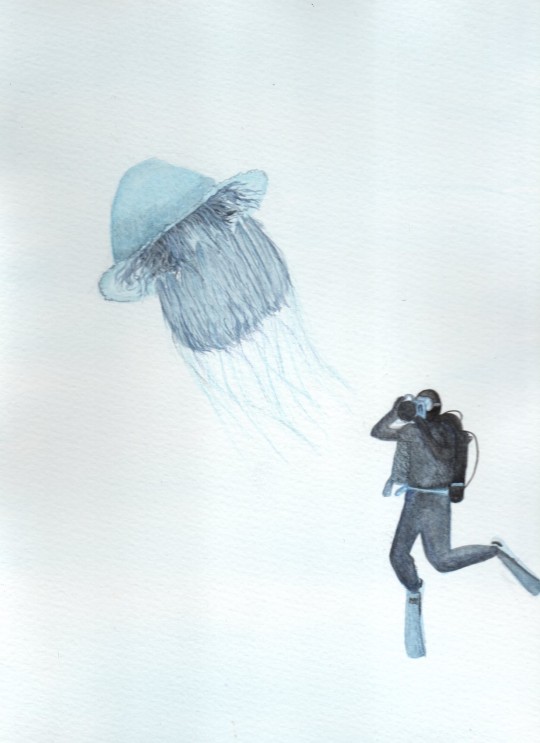

Projet personnel s’articulant autour de la plongée, de l’observation avec un coté scientifique qui me ressemble particulièrement! Il est représenté une raie modula, une baleine bleue et une méduse géante (Nemopilema nomurai). L’océan me passionnant, ce projet m’a vraiment plu à réaliser ! J’ai utilisé comme technique l’aquarelle (que je privilégie lorsque je dessine en lien avec l’océan) mais aussi le crayon de couleur.
0 notes
Text
What makes a giant jellyfish’s sting deadly?
With summer on the way, and some beaches reopening after COVID-19 shutdowns, people will be taking to the ocean to cool off on a hot day. But those unlucky enough to encounter the giant jellyfish Nemopilema nomurai (also known as Nomura’s jellyfish) might wish they had stayed on shore. Now, researchers have identified the key toxins that make the creature’s venom deadly to some swimmers.
What makes a giant jellyfish’s sting deadly? syndicated from https://triviaqaweb.blogspot.com/
0 notes
Text
The venom of a giant jellyfish is so complex that scientists cannot isolate its components
The venom of a giant jellyfish is so complex that scientists cannot isolate its components
US, WASHINGTON (ORDO NEWS) — Somewhere there, in the depths of the ocean, there is a huge jellyfish waiting for prey to release a complex poisonous cocktail through its many long tentacles.
Weighing up to 200 kg, the giant jellyfish Nemopilema nomurai, better known as Nomura jellyfish, is one of the largest jellyfish in the world. Every year, thousands of unsuspecting swimmers in China, Korea,…
View On WordPress
0 notes
Text
Daily Jellyfish Masterlist (A-Z):

A:
B:
✰ Bathykorus bouilloni (Day #2)
C:
D:
E:
F:
G:
H:
I:
J:
K:
L:
M:
N:
✰ Nemopilema Nomurai (Day #3)
O:
P:
Q:
R:
S:
✰ Stygiomedusa gigantea (Day #1)
T:
U:
V:
W:
X:
Y:
Z:

5 notes
·
View notes
Text
This giant jellyfish's venom is so complex, scientists aren't sure what makes it deadly
https://sciencespies.com/nature/this-giant-jellyfishs-venom-is-so-complex-scientists-arent-sure-what-makes-it-deadly/
This giant jellyfish's venom is so complex, scientists aren't sure what makes it deadly
Somewhere out there in the deep lies a huge jellyfish, just waiting to unleash a complex cocktail of venom via its many long tentacles.
Weighing up to 200 kilograms (440 pounds), the giant jellyfish Nemopilema nomurai, more commonly known as Nomura’s jellyfish, is one of the largest jellyfish species in the world, and it stings hundreds of thousands of unsuspecting swimmers in China, Korea, and Japan every year.
When stings occur, the creature’s venom causes an immediate and severe pain, followed by redness and swelling. In rare cases, stings can lead to shock, severe injury, or even death.
Ultimately, we still don’t know what makes this creature’s venom so dangerous (being evidently deadly for some people), but we’re getting closer to finding the truly lethal component.
In a new study, scientists sat down to analyse this incredible venom through genomic sequencing, transcriptomics, and proteomics. In doing so, they discovered an incredibly complex mixture of over 200 sting-related toxins, each of which could be targeting specific organs or harming bodily systems.
“Although we tried to purify the lethal toxin(s) from the venom of N. nomurai, it was excessively difficult to separate them from other proteins individually,” the authors explain in their new paper.
In other words, these toxins are so complex, it’s hard to tease out all the individual factors at play – at least, without resorting to other kinds of experiments.
In the study, the team also cut and froze fresh tentacles straight from a live jellyfish, before centrifuging them to collect nematocysts – a specialised cell in jellyfish that contains a coil of venom.
Carefully extracting the venom’s proteins and separating them into different groups, the researchers injected each protein fraction into mice, to see which ones died.
The results highlight a group of 13 toxin-like proteins that have potentially fatal consequences – some target cell membranes, others target potassium channels, while others have blood-clumping effects.
On a larger scale, the consequences include vascular congestion of the heart, vascular degeneration, cell death in the liver, changes in the kidneys, and inflammation of the lungs.
Analysing the mice post mortem, researchers found pulmonary infection and edema were the most likely cause of death, which is consistent with human reports.
Still, the authors admit it’s difficult to say for sure how each of these individual toxins actually kills animals, suggesting they could be working in tandem.
Better understanding this brew of toxins might help us develop an antidote for this jellyfish’s sting, but first we’d need to explore whether these potentially lethal toxins are equally dangerous to humans.
The study was published in the Journal of Proteome Research.
#Nature
0 notes
Text
What makes a giant jellyfish's sting deadly?
With summer on the way, and some beaches reopening after COVID-19 shutdowns, people will be taking to the ocean to cool off on a hot day. But those unlucky enough to encounter the giant jellyfish Nemopilema nomurai (also known as Nomura's jellyfish) might wish they had stayed on shore. Now, researchers have identified the key toxins that make the creature's venom deadly to some swimmers.
from Tips By Frank https://www.sciencedaily.com/releases/2020/06/200610120958.htm
0 notes
Text
What makes a giant jellyfish's sting deadly?
With summer on the way, and some beaches reopening after COVID-19 shutdowns, people will be taking to the ocean to cool off on a hot day. But those unlucky enough to encounter the giant jellyfish Nemopilema nomurai (also known as Nomura's jellyfish) might wish they had stayed on shore. Now, researchers have identified the key toxins that make the creature's venom deadly to some swimmers.
Latest Science News -- ScienceDaily https://www.sciencedaily.com/releases/2020/06/200610120958.htm
0 notes
Video
youtube
How to draw jellyfish tattoo-jellyfish tattoo meaning-jellyfish tattoo small. In late decades jellyfish blossom thickness and populaces have expanded significantly. Researchers indicate the ascent of sea temperatures (because of a worldwide temperature alteration) and over angling as conceivable impetuses behind these populace blasts. While hotter water temperatures are helpful for jellyfish polyps transforming into grown-up medusa, there is no observational information to bolster these theories. In truth, there is just insufficient documentation existing on long haul jellyfish populace examples to offer much else besides logical hypothesis. A valid example: The sudden and destroying ascend in the beetle populaces that tormented the Midwestern United States in 1874. We have no chance to get of knowing whether this was a cyclic ascent in populace or was brought on by man's intercession with nature. Intermittent grasshopper invasion could have occurred for quite a long time in the Midwest. American pioneers were simply not around to record the pulverization. Social Media https://plus.google.com/u/0/106296181955452800866 https://twitter.com/HowtoDraw20 https://www.instagram.com/asmarbd.m/ https://www.tumblr.com/blog/luckycollectlove http://cowhata.blogspot.com/ One thing is sure: The ascent in jellyfish populaces has fetched untold millions in income misfortune to the tourism business. Australia, Indonesia, Japan, the U.S., Central America, and nations all through the Mediterranean coastline have all accomplished noteworthy ascents in jellyfish populaces in late decades. 2005 Newport Beach California: 1,400 individuals must be dealt with for jellyfish stings in a solitary day. Costa Brava Spain 2006: Over 19,000 shoreline goers were dealt with for jellyfish stings. Mediterranean shorelines have encountered jellyfish groupings of more than 10 jellyfish for every square meter as of late. The shoreline resorts in Mexico have must be shut over and over because of jellyfish pervasion. Australia's destructive box jellyfish populaces have additionally risen drastically. Box jellyfish have relocated the distance to the shores of Hawaii. Hawaiian shorelines have needed to begin posting the same "Lethal Jellyfish" cautioning signs that Australians have figured out how to acknowledge as a method for live in the tallness of jellyfish reproducing season. Box jams and their littlest individuals the Irukadji jellyfish immerse the shores of Northern Australia from November through May. A grown-up box jellyfish contains enough venom to murder 60 individuals. They can kill a full developed grown-up in as meager as 2 minutes. Sting casualties every now and again go into anaphylactic stun if counter-agent venom is not immediately regulated. Gotten regions are accommodated Australian shoreline goers to keep them out of damages way. Irukadji jellyfish display a completely unique issue as to human cooperation. These jellyfish are no bigger than your finger nail and are totally straightforward. In every practical sense they jellyfish are undetectable to shoreline goers. Nets are totally inadequate in confining them from people in general. While their venom is not as quick going about as that of their bigger cousins, there is no antibody venom at present accessible for Irukadji Syndrome. Specialists can just treat the sting casualty's manifestations and expectation the patient survives the experience. In the event that their nearness is distinguished, the shorelines are shut. Tourism is by all account not the only business to endure in light of the worldwide jellyfish blast. On October 23, 2008 alerts started to sound at the Diablo Canyon Nuclear power plant in San Luis Obispo County. Water weight readings from the plants cooling frameworks were soaring without clarification. Submerged scuba groups reviewed the plant's cooling admission framework and verified that 100s of moon jellyfish had totally stuck the admission channels. Authorities had no real option except to shut down the plant. A blossom of apparently inauctious jellyfish had prevailing with regards to doing what years of ecological protestors had neglected to finish. Jellyfish have likewise stopped up desalination plants and ship admissions. Maybe hardest hit industry as of late is the business angling industry. Jellyfish blossoms have stopped up and broken nets, harmed angle gets and undermined to close down angling operations totally in more than one district of the world. The goliath Nomura's jellyfish (Nemopilema nomurai) has even upset angling vessels off the shore of Japan.
0 notes
Photo
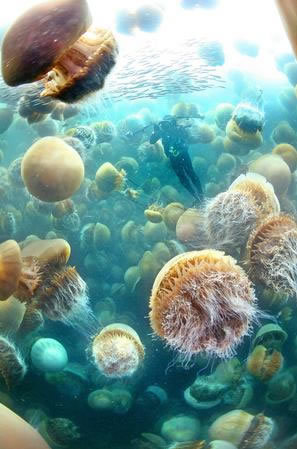
53 notes
·
View notes